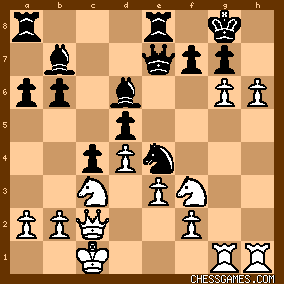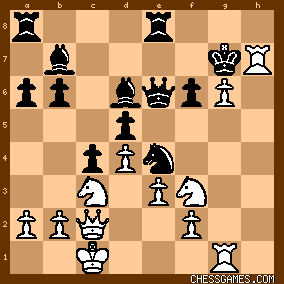|
< Earlier Kibitzing · PAGE 2 OF 2 ·
Later Kibitzing> |
| Apr-08-13 | | Ezzy: <PawnSac: in case you're interested, here's a picture of the early chess clock> From <PawnSac's> link - <By 1883, a mechanical timing device had been invented, called the “tumbling” chess clock. It was first used at a London tournament that year. It was invented by Thomas Bright Wilson (1843-1915) of Manchester, England,> Invented by a guy from my home city. Didn't know that. You learn something new everyday. :-) |
|
Mar-26-16
 | | Penguincw: Ooh, I like the pun.
Anyway, a Saturday puzzle here. I correctly guessed 18.Bxh7+ Kxh7 19.g6+ Kg8, and then clicked on the solution, happy to get it, without knowing why it's good and all. |
|
| Mar-26-16 | | Exploding: I got 18. ♗h7 right, but that is it.
Really I suck at weekend's puzzles. |
|
| Mar-26-16 | | mel gibson: Difficulty insane?
I saw it straight away! |
|
| Mar-26-16 | | yadasampati: <mel gibson> Not insane but very difficult. Sundays are insane :-) But i am not surprised that you saw it instantly. Our subconscious mind is capable of solving problems without the "traditional" computations of our conscious mind. In this respect, I would like to refer to Daniel Tammet (https://en.wikipedia.org/wiki/Danie...), who can perform amazingly complex mathematical tasks (multiplications, divisions, etc.) within seconds. The solutions just come to him: when he thinks of a number he literally sees a shape in his mind. Combining the shapes in a certain way leads to another shape, that he can associate again with a number, being the solution of the problem ... See "The Boy With The Incredible Brain": https://www.youtube.com/watch?v=AbA... I am therefore pretty much convinced that our brains are potentially much more powerful than any current day computer |
|
| Mar-26-16 | | mel gibson: Yadasampati
<But i am not surprised that you saw it instantly. Our subconscious mind is capable of solving problems without the "traditional" computations of our conscious mind.>I could see that if the King takes the Bishop white can bring his 2 pawns in & threatens an open file for it's h Rook.
I have won many games like that by sacrificing a Knight in the same way.
Also the Queen can join in the fun after a Knight swap plus
a second Rook! |
|
| Mar-26-16 | | agb2002: I know this game. |
|
| Mar-26-16 | | dfcx: My line agree with the text on the first two moves
18.Bxh7+ Kxh7 19.g6+ Kg8,
but next I choose
20.h6 f6 21.hxg7
and black can't do much to defend its h file. |
|
| Mar-26-16 | | not not: 21. h6 is brilliant (looks right and feels right); he gives up another piece to rip into king by exchanging pawns (and win his queen); did he see it, when he played Bh7, I don't know; fun game to go through though |
|
| Mar-26-16 | | yadasampati: <mel gibson> Thanks for your reply. I would still recommend to watch the documentary in the second link i gave. |
|
| Mar-26-16 | | morfishine: Seen this one |
|
| Mar-26-16 | | alfiere nero: Interesting how the puzzle had similarities with today's game of the day. |
|
| Mar-26-16 | | patzer2: For today's Saturday puzzle, I figured the relatively unprotected black King side gives White a strong and winning attack with the demolition 18. Bxf7+! I duplicated Akiba Rubinstein's first two moves in the combination with 18. Bxf7+! Kxf7 19. g6+, but after 19...Kg8 I deviated from the game move 20. Nxe4!  (+3.34 @ 29 depth, Stockfish 100814). (+3.34 @ 29 depth, Stockfish 100814). Instead of Rubinstein's 20. Nxe4!  , I went with 20. h4 , I went with 20. h4  (diagram below): (diagram below): 
click for larger viewHere (diagram above) the computers indicate best play is 20...f6 21. hxg7 Qe6 22. Rh8+ Kxg7 23. Rh7+  (+3.79 @ 18 depth, Deep Fritz 15): (+3.79 @ 18 depth, Deep Fritz 15): 
click for larger viewFrom there (diagram above) my move-by-move look with Deep Fritz 15 continues 23...Kf8 (23...Kg8 24. Rgh1  +5.65 @ 19 depth) 24. Rxb7 Re7 25. g7+ Kf7 26. Nxe4! dxe4 27. Rxe7+ +5.65 @ 19 depth) 24. Rxb7 Re7 25. g7+ Kf7 26. Nxe4! dxe4 27. Rxe7+  (+6.55 @ 20 depth) with a clearly won position. (+6.55 @ 20 depth) with a clearly won position. P.S.: So where did Black go wrong? The computers indicate 17...a6?, allowing the demolition 18. Bxh7+!  (+4.69 @ 42 depth, Stockfish 5SE), was the losing move. (+4.69 @ 42 depth, Stockfish 5SE), was the losing move. Instead, 17...g6 18. Bxe4 dxe4 19. Nh2!  (+1.28 @ 26 depth, Komodo 9.42) puts up more resistance. (+1.28 @ 26 depth, Komodo 9.42) puts up more resistance. Early in the opening, instead of 7...b6 8. cxd5  (+0.37 @ 32 depth, Stockfish 6), the computers prefer the popular move 7... c6 = as in M Rodshtein vs M Roiz, 2015 or the slightly less fashionable alternative 7... h6 = as in Harikrishna vs Eljanov, 2014 (+0.37 @ 32 depth, Stockfish 6), the computers prefer the popular move 7... c6 = as in M Rodshtein vs M Roiz, 2015 or the slightly less fashionable alternative 7... h6 = as in Harikrishna vs Eljanov, 2014 |
|
| Mar-26-16 | | kevin86: White forces the position open for attack. |
|
Mar-26-16
 | | Breunor: I went for 18 N x e4 d x e4 and then 19 B x h7 K x h7 and 20 g6 ch. Does this move order fail (my instincts say it does but I don't' see why.) |
|
| Mar-26-16 | | Whitehat1963: What happens if 25...Qe4 or 25...Be4? |
|
Mar-26-16
 | | Breunor: I don't have a computer, but I think on 25 ..... Qe4 there is Qd7., maybe Qh5. On 25 ... Be4 there is probably Qh5. |
|
Mar-26-16
 | | offramp: I went for 18.Bg6. Does that win?
I was basing it on an old Jon Nunn game. |
|
| Mar-26-16 | | patzer2: <Whitehat1963> If 25...Qe4, <Breunor>'s 26. Qh5 leads to mate-in-five. The computer pick is 25...Qe5 26. Qxf6 which is good for mate-in-four. If 25...Be4, <Breunor>'s 26. Qh5 yields mate-in-five. <offramp> My computer indicates 18. Bg6 loses to 18...fxg6  or 18...hxg6 or 18...hxg6  (-3.20 @ 20 depth, Deep Fritz 15). (-3.20 @ 20 depth, Deep Fritz 15). |
|
| Mar-26-16 | | patzer2: <Breunor> Your 18. Nxe4 dxe4 19. Bxh7+ Kxh7 20. g6+ idea wins after 20...Kg8 21. h6 fxg6 [21...f5 22. Qxc4+  (+3.31 @ 18 depth, Deep Fritz 15)] 22. Nh5! (+3.31 @ 18 depth, Deep Fritz 15)] 22. Nh5!  (+4.63 @ 37 depth, Stockfish 6). (+4.63 @ 37 depth, Stockfish 6). |
|
Mar-26-16
 | | offramp: Thank you, <Patzer2>. Back to my drawing board. |
|
Mar-26-16
 | | Breunor: Thanks Patzer 2! |
|
| Mar-26-16 | | Razgriz: A bit late to the party. Saw the initial 18. Bxh7+, the King would have to take back because otherwise, lets say Kh8 or Kf8, white can just march the pawns down and queen. However, it was quite tough to follow up on that. I didn't see clearing up the middle by exchanging knights to allow the queen to barge in. |
|
Feb-22-17
 | | Jimmy720: memorize |
|
| Aug-26-24 | | andrea volponi: 17...g6(-la migliore difesa)-hxg6 hxg6 -Rh6! Nxf2 -Qxf2 con vantaggio dei bianchi ⩲\+-. |
|
 |
|
< Earlier Kibitzing · PAGE 2 OF 2 ·
Later Kibitzing> |





